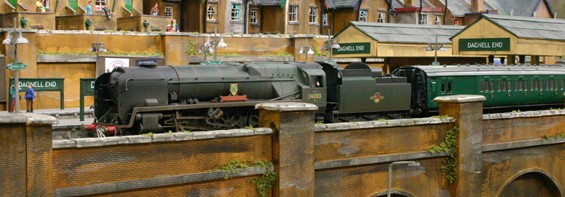
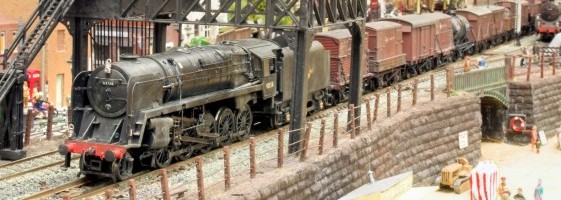
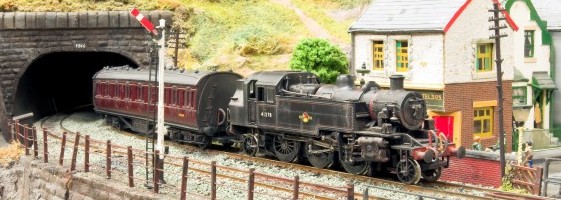
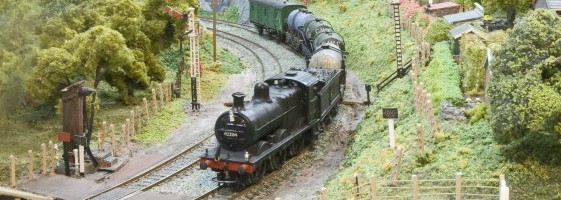
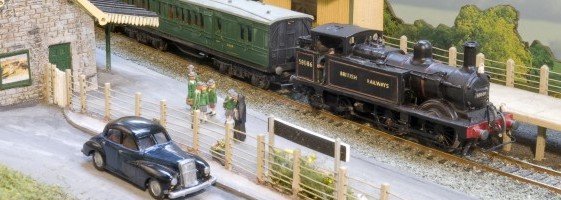

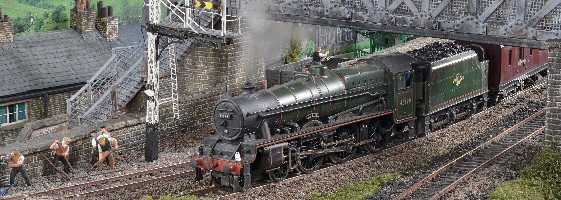
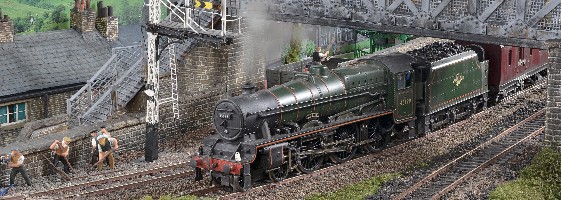








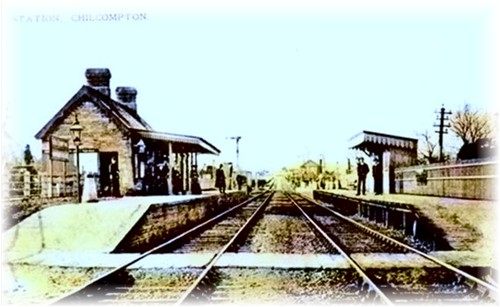 The
Station of Chilcompton was situated some 14 miles from
Bath Green Park Station in the north and 57 miles from
Bournemouth West Station in the south. The station,
which was just to the south of Midsomer Norton, was some
600 feet above sea level, which often caused problems
with snow in the winter. The village of Chilcompton had
somewhere between 600 and 800 inhabitants throughout the
life of the railway. Other than on the railway or the
land the main employers were either at Chilcompton Saw
Mills which was adjacent to the railway station or at
the New Rock Coal Mine which was close by. Chilcompton
Station was opened on 20th July 1874 and was situated on
the south side of the valley of the River Somer. The
railway through Chilcompton from Bath to Evercreech
Junction was opening as a single line. Following a
decision at the S&DJR Officers meeting of 21st Oct 1875
a passing-loop was provided at Chilcompton early in
1876. This resulted in the opening of the first
signal-box at Chilcompton, which was the subject of a
Board of Trade Inspection report in March 1876.
Progressively the section from Midford to Evercreech was
doubled between 1886 and 1892. The line from Chilcompton
to Binegar was doubled in 1885, and from Chilcompton to
Radstock in 1886. In conjunction with this the first
signal-box was closed in 1886 and replaced by a Type 2
box mentioned (Board of Trade report dated 14th April
1886). The station was closed with the rest of the line
on Saturday 5th March 1966 (The last special trains
actually ran the day after on Sunday 6th but the line
was closed to normal traffic after service on the
Saturday). The second signal box which was opened 1886
and was closed on 11th April 1965. It was built to the
standard S&D Type 2 design and was equipped with a 13
lever Stevens Pattern Frame with 4 1/8-inch centres. The
signalling at the station was unusual in that no ground
signals were provided when the second signal box was
built and all shunting was controlled by hand signals.
During 1960 the signal box was open between 0640 and
2110 on Mondays to Saturdays and was closed all day on
Sundays. The box had a closing switch, which meant
trains could pass through the station, when the box was
closed as long as access to the goods yard was not
required. During the life of the this second signal box
brickwork was added to the upper storey under the
windows, it is thought this is due to rot or other
damage and it is in this condition we have modelled it.
The down yard was provided with a goods shed and a 5 ton
crane together with two water towers. These were used to
replenish the tanks of locomotives used to bank freight
trains up the 1 in 50 grade from Radstock to Masbury.
For Safety reasons freight trains were banked but
passenger trains were piloted thus providing the
spectacle of double headed passenger trains. In the
1930’s the sidings at the station were extended to
provide a loading dock so coal could be brought by road
from the New Rock Colliery. The Colliery was opened in
1819 and was closed on 28th September 1968. It had a 4 ½
feet diameter winding shaft and employed around 200 men.
The goods yard had ceased to handle traffic on 15th June
1964. The Club would like to thank Chris Osment, S&DRT
Signalling Steward, for helping with some of the above
information.
The
Station of Chilcompton was situated some 14 miles from
Bath Green Park Station in the north and 57 miles from
Bournemouth West Station in the south. The station,
which was just to the south of Midsomer Norton, was some
600 feet above sea level, which often caused problems
with snow in the winter. The village of Chilcompton had
somewhere between 600 and 800 inhabitants throughout the
life of the railway. Other than on the railway or the
land the main employers were either at Chilcompton Saw
Mills which was adjacent to the railway station or at
the New Rock Coal Mine which was close by. Chilcompton
Station was opened on 20th July 1874 and was situated on
the south side of the valley of the River Somer. The
railway through Chilcompton from Bath to Evercreech
Junction was opening as a single line. Following a
decision at the S&DJR Officers meeting of 21st Oct 1875
a passing-loop was provided at Chilcompton early in
1876. This resulted in the opening of the first
signal-box at Chilcompton, which was the subject of a
Board of Trade Inspection report in March 1876.
Progressively the section from Midford to Evercreech was
doubled between 1886 and 1892. The line from Chilcompton
to Binegar was doubled in 1885, and from Chilcompton to
Radstock in 1886. In conjunction with this the first
signal-box was closed in 1886 and replaced by a Type 2
box mentioned (Board of Trade report dated 14th April
1886). The station was closed with the rest of the line
on Saturday 5th March 1966 (The last special trains
actually ran the day after on Sunday 6th but the line
was closed to normal traffic after service on the
Saturday). The second signal box which was opened 1886
and was closed on 11th April 1965. It was built to the
standard S&D Type 2 design and was equipped with a 13
lever Stevens Pattern Frame with 4 1/8-inch centres. The
signalling at the station was unusual in that no ground
signals were provided when the second signal box was
built and all shunting was controlled by hand signals.
During 1960 the signal box was open between 0640 and
2110 on Mondays to Saturdays and was closed all day on
Sundays. The box had a closing switch, which meant
trains could pass through the station, when the box was
closed as long as access to the goods yard was not
required. During the life of the this second signal box
brickwork was added to the upper storey under the
windows, it is thought this is due to rot or other
damage and it is in this condition we have modelled it.
The down yard was provided with a goods shed and a 5 ton
crane together with two water towers. These were used to
replenish the tanks of locomotives used to bank freight
trains up the 1 in 50 grade from Radstock to Masbury.
For Safety reasons freight trains were banked but
passenger trains were piloted thus providing the
spectacle of double headed passenger trains. In the
1930’s the sidings at the station were extended to
provide a loading dock so coal could be brought by road
from the New Rock Colliery. The Colliery was opened in
1819 and was closed on 28th September 1968. It had a 4 ½
feet diameter winding shaft and employed around 200 men.
The goods yard had ceased to handle traffic on 15th June
1964. The Club would like to thank Chris Osment, S&DRT
Signalling Steward, for helping with some of the above
information.